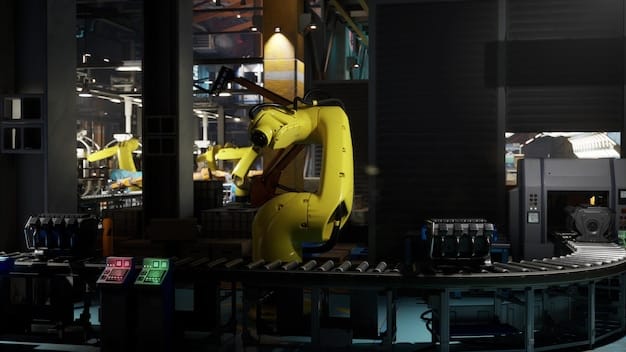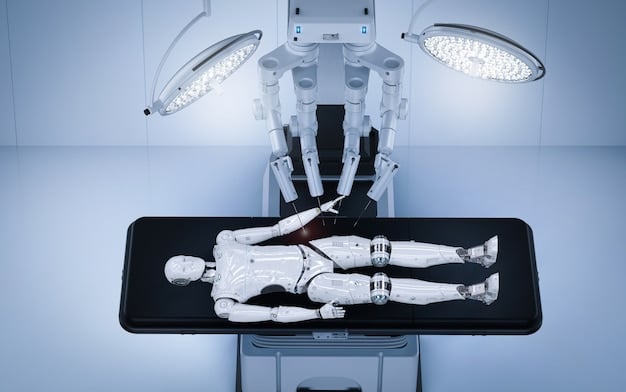US Robotics Industry: Automation Trends & Future Applications

The US robotics industry is experiencing rapid growth, driven by advancements in artificial intelligence and automation, leading to transformative applications across manufacturing, healthcare, and logistics, poised fundamentally to reshape the nation’s economic landscape.
The landscape of American industry is currently undergoing a profound transformation, propelled by the relentless march of technological innovation. At the forefront of this revolution stands the emergence and rapid expansion of the US robotics industry: automation trends and future applications that promise to redefine productivity, efficiency, and even the very nature of work across the nation. This dynamic sector, once confined to the pages of science fiction, is now a cornerstone of modern manufacturing and a vital component of diverse industries, from precision surgery to complex logistics.
The Evolution of Robotics in the US: A Historical Overview
Understanding the current state and future trajectory of robotics in the United States requires a brief journey through its pioneering past. From early industrial automation to today’s sophisticated AI-powered machines, the US has played a pivotal role in shaping the global robotics landscape. This evolutionary process has been marked by significant breakthroughs, each contributing to the industry’s exponential growth.
Early Beginnings and Industrial Adoption
The foundational principles of industrial robotics took root in the mid-22th century, with figures like George Devol and Joseph Engelberger often credited with developing the first programmable industrial robot, the “Unimate,” in the 1950s. This invention marked a turning point, ushering in an era where machines could perform repetitive, dangerous, or precise tasks with unprecedented consistency.
- Automated Assembly Lines: Early robots were predominantly utilized in automotive manufacturing for welding and material handling.
- Safety and Efficiency Gains: They improved worker safety by taking on hazardous tasks and boosted production line efficiency.
- Limited Dexterity: These first-generation robots were typically large, rigid, and lacked the nuanced capabilities of their modern counterparts.
The initial adoption was slow but steadily gained traction as businesses recognized the long-term benefits of automation, including reduced labor costs, increased output, and improved product quality. This phase laid the groundwork for the more complex robotic systems we see today, establishing a precedent for continuous innovation and adaptation within the industrial sector.
From Fixed-Arm to Mobile Robotics
The progression moved beyond fixed-arm industrial robots. The development of mobile robots and automated guided vehicles (AGVs) in the latter half of the 20th century expanded the scope of robotics beyond static manufacturing environments. These machines could transport materials across vast warehouses or navigate complex environments, further enhancing logistics and supply chain operations. This shift marked a critical expansion of robotics’ practical applications.
As microprocessors became more powerful and sensors more refined, robots gained greater autonomy and perception. This included the ability to interpret their surroundings, make real-time decisions, and interact with the physical world in increasingly sophisticated ways. The blending of mechanical precision with intelligent software became the hallmark of robotic advancement.
The historical trajectory reveals a persistent push towards greater utility and integration. Each decade has seen new barriers broken, fostering a robust environment for innovation. This continuous evolution underpins the rapid trends currently observable within the US robotics industry, highlighting its adaptability and enduring relevance.
Key Automation Trends Driving the US Robotics Industry
The US robotics industry is currently being reshaped by several pivotal automation trends. These trends are not isolated phenomena but rather interconnected forces that are collectively accelerating the deployment and sophistication of robotic systems across various sectors. Understanding these drivers is crucial for grasping the industry’s present momentum and future direction.
The Rise of Collaborative Robots (Cobots)
Perhaps one of the most transformative trends is the proliferation of collaborative robots, or “cobots.” Unlike traditional industrial robots that operate in caged-off areas for safety reasons, cobots are designed to work safely alongside human employees, often without the need for extensive safety guarding. This collaborative capability opens up new avenues for automation, particularly in smaller businesses and tasks requiring human dexterity alongside robotic precision.
- Enhanced Flexibility: Cobots can be easily reprogrammed and redeployed for different tasks, offering significant flexibility.
- Human-Robot Collaboration: They augment human capabilities, taking over repetitive or ergonomically challenging tasks while humans handle more complex decision-making or fine motor skills.
- Increased Accessibility: Their lower cost and ease of integration make automation accessible to a wider range of companies.
The appeal of cobots lies in their ability to combine the best attributes of human intelligence and robotic efficiency. This synergy often leads to improved productivity, reduced error rates, and a more dynamic work environment where skill sets are optimally utilized.
Artificial Intelligence (AI) and Machine Learning (ML) Integration
The integration of artificial intelligence and machine learning is profoundly impacting the capabilities of modern robots. AI and ML enable robots to “learn” from data, perceive complex environments, make autonomous decisions, and even adapt to unforeseen circumstances. This intelligent layer transforms robots from mere programmable machines into genuinely smart partners.
For instance, AI-powered vision systems allow robots to identify and inspect products with greater accuracy than human eyes, while ML algorithms enable them to refine their movements and processes over time, leading to continuous improvement in performance. This intelligence is critical for handling variability and complexity in manufacturing, logistics, and service applications.
The ability of robots to process vast amounts of data, recognize patterns, and learn from experience means they are becoming increasingly capable of managing tasks that once required significant human intervention and cognitive reasoning. This trend ensures that robots are not only performing tasks but optimizing them.
Mobile Robotics and Autonomous Navigation
Beyond fixed-station applications, mobile robotics, including autonomous mobile robots (AMRs) and automated guided vehicles (AGVs), are gaining significant traction. These systems are revolutionizing logistics, warehousing, and even service industries by autonomously transporting goods, performing inspections, or delivering services within complex, dynamic environments.
The sophistication of their navigation systems, utilizing technologies like LiDAR, cameras, and advanced sensor fusion, allows AMRs to operate safely and efficiently alongside human workers. This capability is vital for businesses seeking to optimize their internal material flow and reduce the reliance on manual transportation, fostering a more streamlined operational model.
The expansion of mobile robotics means automation is no longer confined to specific production lines but can permeate the entire operational footprint of a business, transforming how goods move and how services are delivered. This flexibility is a critical enabler for scalability and responsiveness in fast-paced markets.
Future Applications of Robotics Across US Sectors
The pervasive influence of robotics is expanding far beyond its traditional industrial strongholds, venturing into diverse sectors across the United States. These emerging applications demonstrate the versatility and adaptability of robotic technology, promising to revolutionize everything from healthcare delivery to environmental management.

Robotics in Healthcare and Medicine
The healthcare sector is experiencing a significant infusion of robotic technology, transforming patient care, surgical procedures, and pharmaceutical distribution. Surgical robots, for example, enable minimally invasive procedures with enhanced precision and control, leading to faster recovery times and better patient outcomes. These systems provide surgeons with magnified, 3D views and highly articulated instruments, extending human capabilities beyond what is manually possible.
Beyond the operating room, robots are proving invaluable in hospitals for tasks such as delivering medications and supplies, sterilizing rooms, and assisting with rehabilitation therapies. This reduces the burden on human staff, allowing them to focus on direct patient interaction requiring empathy and complex decision-making.
- Surgical Assistance: Enhancing precision in complex operations.
- Logistics and Delivery: Transporting materials and medications within healthcare facilities.
- Patient Rehabilitation: Assisting in physical therapy and mobility support.
The application of robotics in healthcare is poised to grow exponentially, driven by the aging population, the need for efficiency, and advancements in AI that enable more sophisticated diagnostic and therapeutic robotic tools.
Transforming Agriculture and Food Production
Agriculture, traditionally a labor-intensive industry, is undergoing a quiet revolution with the adoption of robotic systems. These technologies are addressing critical challenges such as labor shortages, resource efficiency, and the need for sustainable farming practices. Agricultural robots can perform tasks like precision planting, harvesting, weeding, and even livestock management with remarkable accuracy and efficiency.
Robotic harvesters, for instance, can selectively pick ripe fruits and vegetables without damaging the crop, extending their shelf life and reducing waste. Drones equipped with sensors map fields, monitor crop health, and precisely apply water or nutrients, minimizing resource consumption and environmental impact. This level of precision farming is critical for feeding a growing global population sustainably.
The integration of robotics in agriculture is a game-changer, promising to enhance productivity, reduce environmental footprint, and ensure the long-term viability of food production systems in the US. It paves the way for more resilient and efficient farming operations.
Logistics, Warehousing, and Supply Chain Optimization
The e-commerce boom and the increasing demand for rapid delivery have positioned robotics as an indispensable tool for logistics and warehousing operations. Autonomous mobile robots (AMRs) tirelessly navigate warehouses, optimizing storage, retrieving goods, and preparing orders for shipment. This automation significantly speeds up processing times, reduces operational costs, and minimizes human errors.
Robotic arms are used for sorting, packing, and palletizing, ensuring a smooth and efficient flow of goods through distribution centers. The ability of these systems to operate 24/7 with consistent performance is critical for meeting the demands of modern supply chains, especially during peak seasons. The efficiency gains are enormous.
Beyond the warehouse, autonomous vehicles are beginning to play a role in last-mile delivery, particularly in urban environments. This comprehensive automation of the supply chain from manufacturing to the consumer’s doorstep is a primary focus for robotics deployment, promising to make logistics more robust and responsive than ever before.
Challenges and Opportunities in the US Robotics Sector
While the US robotics industry presents a landscape of immense potential, it is not without its significant challenges. Addressing these hurdles is crucial for sustained growth and for realizing the full socioeconomic benefits that widespread robotic deployment can offer. Simultaneously, these challenges often present unique opportunities for innovation and strategic development.
Workforce Reskilling and Job Displacement Concerns
One of the most frequently discussed challenges is the potential impact of automation on the workforce. As robots become more capable and ubiquitous, concerns about job displacement and the need for significant workforce reskilling are paramount. While robots often take over repetitive or hazardous tasks, this necessitates that human workers transition to roles requiring different skill sets, often involving robot supervision, programming, or maintenance.
This challenge, however, also presents a significant opportunity. Proactive investment in education and training programs can equip the existing workforce with the skills needed to thrive in an automated economy. This includes developing expertise in robotics engineering, data analysis, cybersecurity for robotic systems, and human-robot interaction design. The focus shifts from manual labor to cognitive and supervisory roles.
- Training Gaps: Need for tailored educational programs to update worker skills.
- New Job Creation: Automation often creates new categories of jobs that require advanced technical skills.
- Policy Development: Government and industry collaboration on workforce development strategies.
Effectively managing this transition is critical for ensuring that the benefits of automation are widely shared, fostering economic growth without exacerbating social inequality. Policy initiatives and corporate training programs will play a vital role here.
Ethical Considerations and Regulatory Frameworks
The increasing autonomy and intelligence of robots raise complex ethical questions. Issues such as data privacy (especially with robots equipped with advanced sensors), accountability in the event of errors or accidents, and the broader societal implications of highly intelligent machines require careful consideration. Establishing clear ethical guidelines and robust regulatory frameworks is essential for responsible development and deployment.
This area presents an opportunity for the US to lead in setting global standards for robotic ethics and governance. By proactively addressing these concerns, the industry can build public trust and ensure that robotic technology is developed and used in ways that align with societal values. This includes debates on algorithmic transparency and the responsible use of AI in autonomous systems.
Developing these frameworks involves collaboration between technologists, ethicists, legal experts, and policymakers. It’s a complex undertaking but one that is vital for the long-term societal acceptance and integration of robotics.
Funding and Investment Landscape
While the US robotics sector is attracting significant investment, securing sustained funding, especially for early-stage startups and cutting-edge research, remains a challenge. The capital intensity of hardware development and the often-long development cycles mean that access to patient capital is crucial. Furthermore, the ability to scale production and move from prototypes to commercial deployment requires substantial financial backing.
Despite this, the burgeoning market for robotic solutions presents enormous investment opportunities. Venture capital, corporate venture arms, and government grants are increasingly flowing into the sector. The opportunity lies in attracting diverse funding sources and fostering ecosystems that support innovative companies from concept to market saturation. This includes incentives for domestic manufacturing.
Ensuring a robust funding pipeline is fundamental for maintaining the US’s competitive edge in robotics, allowing for continued research, development, and commercialization of next-generation robotic systems. Strategic partnerships between academia, industry, and government can also help de-risk crucial investments.
Geographic Hubs and Research Powerhouses in US Robotics
The vibrancy of the US robotics industry is not uniformly distributed but rather concentrated in several key geographic hubs that serve as epicenters of research, development, and commercialization. These regions benefit from a unique confluence of academic excellence, venture capital, incubators, and a skilled workforce, fostering a fertile ground for innovation.
Boston, Massachusetts: A Nucleus of Innovation
Boston and the surrounding Massachusetts area have firmly established themselves as a leading robotics hub globally. This region is home to world-renowned academic institutions like MIT, Harvard, and Northeastern University, which are at the forefront of robotics research and engineering education. These universities feed a continuous stream of talent and groundbreaking research into the local ecosystem.
Beyond academia, Boston boasts a high concentration of robotics startups and established companies that specialize in diverse areas, including collaborative robots, industrial automation, and surgical robotics. The presence of numerous venture capital firms and a strong entrepreneurial culture further fuels this growth, providing the necessary funding and support for new ventures to flourish.
- Academic Excellence: Premier universities drive fundamental and applied research.
- Startup Ecosystem: High density of innovative robotics companies.
- Venture Capital: Strong funding environment supports new technologies and ventures.
The collaborative spirit between academia, industry, and investment communities is a hallmark of Boston’s success, creating a dynamic environment that consistently pushes the boundaries of robotic capabilities.
Pittsburgh, Pennsylvania: Robotics and AI Synergy
Pittsburgh has emerged as another formidable hub, largely thanks to Carnegie Mellon University’s (CMU) Robotics Institute, one of the largest and most respected robotics research and education centers in the world. CMU has been a pioneer in autonomous driving, industrial robotics, and AI, attracting top talent and significant research funding.
The city has successfully leveraged its academic strength to build a thriving commercial robotics sector. Numerous spin-off companies from CMU, along with established tech firms, have chosen Pittsburgh as their base, drawn by the talent pool and the supportive ecosystem. The focus here often leans towards AI-driven autonomous systems, including self-driving cars and advanced manufacturing solutions.
Pittsburgh’s strategic investment in robotics and AI has transformed it into a critical center for developing the next generation of intelligent machines, solidifying its reputation as a significant player in the national robotics landscape.
Silicon Valley and California’s Diverse Robotics Scene
While perhaps more known for software and internet innovation, California, particularly Silicon Valley and southern California, is a significant player in robotics. This region benefits from a vast pool of software engineering talent, crucial for developing the AI and machine learning components that drive modern robots. Companies here often focus on robotics for logistics, consumer applications, and advanced manufacturing.
The proximity to major tech companies, a robust venture capital environment, and a culture of rapid innovation contribute to California’s strong robotics presence. Universities like Stanford and UC Berkeley also contribute significantly to fundamental robotics research, ensuring a steady pipeline of intellectual property and skilled graduates. California’s diverse industry base also leads to varied robotic applications, from agricultural automation to entertainment robotics.
These geographic concentrations demonstrate how localized ecosystems, nurtured by a combination of academic prowess, investment, and entrepreneurial drive, are critical to the sustained growth and leadership of the US robotics industry.
Economic Impact and Future Outlook of US Robotics
The economic impact of the US robotics industry is profound and multifaceted, extending far beyond the direct revenue generated by robot sales themselves. It encompasses productivity gains, job transformation, and the fostering of new industries. Looking ahead, the future outlook for this sector remains exceptionally positive, driven by continued technological advancement and growing demand.
Productivity Gains and Global Competitiveness
One of the most significant economic benefits of robotics is the substantial increase in productivity. By automating repetitive, precise, or dangerous tasks, robots allow businesses to produce more goods, more consistently, and often at a lower cost. This improved efficiency is critical for maintaining and enhancing the global competitiveness of US industries, particularly in manufacturing, which has seen a resurgence in automation.
Robots enable operations to run 24/7, reduce errors, and minimize waste, all of which contribute to a more optimized production process. This leads to higher output per worker and per unit of capital, strengthening the broader economy and making US-based businesses more attractive in international markets. The ability to innovate rapidly is also enhanced by robotic R&D.
The impact is not limited to large corporations; as robotics technology becomes more accessible and affordable, small and medium-sized enterprises (SMEs) are also beginning to realize these productivity benefits, allowing them to compete more effectively.
Investment and Job Creation in Adjacent Sectors
While concerns about job displacement are valid, the growth of the robotics industry also spurs significant job creation in adjacent sectors. This includes roles in robot design, engineering, software development, installation, maintenance, and training. A thriving robotics sector creates demand for skilled workers in new and emerging disciplines, fostering a more technologically advanced workforce.
Furthermore, the increased productivity enabled by robotics can lead to company expansion, which in turn creates more jobs within the broader economy for tasks that cannot be automated, such as creative roles, strategic planning, or customer service. The demand for industrial automation components and supporting infrastructure also stimulates growth in other manufacturing sectors.
- High-Skilled Jobs: Creation of roles requiring expertise in robotics, AI, and data science.
- Ecosystem Growth: Stimulates growth in component manufacturing, software, and services.
- Economic Multiplier Effect: Investment in robotics often leads to broader economic benefits.
The financial investment flowing into robotics R&D and commercialization is also a significant economic driver, fostering innovation clusters and attracting talent. This virtuous cycle contributes to overall economic dynamism.
Long-Term Growth Projections and Market Expansion
The long-term outlook for the US robotics industry is robust, with analysts projecting significant continuous growth over the next decade. This growth will be fueled by several factors, including the increasing sophistication and versatility of robotic systems, expanding applications across new industries, and the ongoing demand for automation to address labor shortages and supply chain vulnerabilities. The market is far from saturated.
Emerging areas such as service robotics (for hospitality, retail, and personal care), construction robotics, and even space exploration robotics represent massive untapped opportunities. As costs decrease and capabilities increase, robots will become increasingly integrated into daily life and business operations, creating ever-larger market opportunities.
The US is well-positioned to maintain its leadership in robotics innovation, given its strong research infrastructure, vibrant startup ecosystem, and significant investment capacity. The convergence of AI, advanced materials, and connectivity (5G/6G) will further accelerate this growth, ushering in an era of truly intelligent and adaptive robotic systems that will redefine economic possibilities.
Societal Impact and Ethical Considerations of Robotics
Beyond economic metrics, the integration of robotics into society has profound societal implications and raises critical ethical questions. Understanding these broader impacts is essential for guiding responsible development and ensuring that robotic advancements serve the greater good, enhancing human well-being and capability.
Work-Life Balance and Human Enhancement
Robotics has the potential to significantly impact work-life balance by taking over mundane, repetitive, or dangerous tasks, thereby freeing up human workers to engage in more creative, strategic, or personally fulfilling activities. In certain industries, this can lead to safer working conditions and reduced physical strain. Automation enables humans to focus on higher-value tasks that require uniquely human skills like critical thinking, emotional intelligence, and complex problem-solving.
Moreover, assistive robotics and exoskeletons are emerging as powerful tools for human enhancement, aiding individuals with disabilities or providing support for physically demanding jobs. These technologies can improve quality of life, extend career longevity for some, and enable greater independence. However, discussions about the definition of “enhancement” and equitable access remain crucial to avoid creating new divides.
The goal should be to augment human capabilities rather than replace them entirely, fostering a symbiotic relationship between humans and machines that can lead to overall societal benefit and improved quality of life.
Data Privacy, Security, and Algorithmic Bias
As robots become more autonomous and connected, often collecting vast amounts of data through sensors (cameras, microphones, LiDAR), questions of data privacy and security become paramount. Protecting this sensitive information from unauthorized access or misuse is a significant challenge. Ensuring the secure operation of robotic systems, especially those in critical infrastructure or personal care, is non-negotiable.
Furthermore, the algorithms that govern robotic behavior can inherit biases from the data they are trained on, leading to discriminatory or unfair outcomes. Addressing algorithmic bias is crucial for ensuring that robotic systems are fair, equitable, and do not perpetuate or amplify existing societal inequalities. This requires careful attention to data diversity, transparency in algorithm design, and robust testing protocols.
- Data Protection: Safeguarding information collected by robotic systems.
- Cybersecurity Risks: Protecting robots from malicious attacks and ensuring system integrity.
- Bias Mitigation: Developing fair and unbiased algorithms to prevent discriminatory outcomes.
Developing strong regulatory frameworks and ethical guidelines for data governance and algorithmic fairness is vital to building public trust and ensuring responsible deployment of robotics.
Societal Acceptance and Regulatory Landscape
The widespread adoption of robotics hinges not only on technological advancement but also on societal acceptance. Public perception, often shaped by media portrayals and personal experiences, plays a significant role in how readily these technologies are embraced. Addressing public concerns, from job security to ethical implications, through transparent communication and inclusive dialogue is key.
The regulatory landscape for robotics is still evolving. Establishing clear, flexible, and adaptive regulations that balance innovation with safety, ethical considerations, and societal impact is a complex but necessary task. This includes defining liability in autonomous systems, establishing standards for human-robot interaction, and addressing the social safety net implications of automation.
A proactive and collaborative approach involving governments, industry, academia, and civil society will be essential to shape a regulatory environment that fosters innovation while ensuring robotics serves as a force for good in American society, addressing both its promises and its pitfalls responsibly.
Technological Advancements Fueling Robotics Growth
The current surge in the US robotics industry is not accidental but is directly attributable to several concurrent technological advancements that have collectively unlocked new possibilities for robotic capability and application. These innovations represent the bedrock upon which the next generation of intelligent machines is being built.
Advanced Sensor Technology and Computer Vision
The ability of robots to perceive and interact with their environment relies heavily on sophisticated sensor technology. Recent improvements in LiDAR (Light Detection and Ranging), high-resolution cameras, force-torque sensors, and haptic feedback systems have dramatically enhanced robots’ spatial awareness, object recognition, and tactile sensitivity. This means robots can now operate with greater precision, navigate complex environments, and handle delicate objects without damage.
Computer vision, powered by deep learning frameworks, has made particularly rapid strides. Robots can now “see” and interpret visual information with unprecedented accuracy, allowing them to identify specific items, inspect product quality, recognize human gestures, and even read complex blueprints. This perceptual capability is crucial for applications ranging from autonomous vehicles to precision manufacturing and collaborative robotics. The sheer volume of data processed by these sensors is enormous, continually improving robotic perception.
- Enhanced Perception: Allowing robots to understand their surroundings in detail.
- Improved Navigation: Enabling safer and more efficient movement in dynamic spaces.
- Quality Control: Automating detailed inspection tasks with high accuracy.
The ongoing miniaturization and cost reduction of these advanced sensors are making highly perceptive robots increasingly accessible for a wider range of applications.
Edge Computing and 5G Connectivity
The proliferation of intelligent robots generates vast amounts of data that require rapid processing. Edge computing, which processes data closer to the source (i.e., on the robot itself or a nearby server), effectively reduces latency and bandwidth requirements. This local processing enables real-time decision-making for autonomous systems, which is critical for safety and efficiency in dynamic environments like factory floors or public spaces.
Complementing edge computing is the rollout of 5G connectivity. The high bandwidth and ultra-low latency of 5G networks facilitate seamless communication between robots, cloud-based AI systems, and human operators. This enables complex swarm robotics, remote operation of robots, and the continuous updating of robotic software and AI models with minimal delay. The combined power of edge computing and 5G creates a robust, responsive, and highly interconnected robotic ecosystem.
This connectivity transforms standalone robots into components of larger, intelligent networks, facilitating distributed intelligence and collaborative task execution, essential for scaling complex automation solutions.
Advanced Materials and Energy Solutions
The physical design and operational efficiency of robots are continually improved by advancements in materials science and energy solutions. Lighter, stronger, and more flexible materials (like advanced composites and even soft robotics materials) allow for the construction of more agile, durable, and safer robots, particularly cobots designed to interact with humans. These materials also enable more complex and responsive mechanical designs.
Meanwhile, breakthroughs in battery technology, energy harvesting, and efficient motor designs are extending the operational lifespan of mobile robots and reducing their energy footprint. Longer battery life means robots can work for extended periods without recharging, improving overall productivity and reducing downtime. The move towards more energy-efficient components aligns with broader sustainability goals.
These material and energy innovations are not merely incremental; they are foundational, enabling robots to become more powerful, safer, and more autonomous, broadening their applicability across virtually every sector of the US economy, ensuring long-term operational viability.
| Key Aspect | Brief Description |
|---|---|
| 🚀 Trend: Cobots | Collaborative robots working alongside humans, enhancing flexibility and safety in various industries. |
| 🏥 Application: Healthcare | Robots assisting in surgeries, logistics, and patient care for improved precision and efficiency. |
| 🌉 Hub: Boston, MA | A leading center for robotics innovation, driven by top universities and a strong startup ecosystem. |
| 💡 Tech: AI/ML Integration | Enabling robots to learn, perceive, and make autonomous decisions, boosting intelligence and adaptability. |
Frequently Asked Questions About the US Robotics Industry
▼
The primary driving force behind the growth of the US robotics industry is the increasing sophistication of artificial intelligence and machine learning, coupled with the rising demand for automation to enhance productivity, address labor shortages, and improve safety across various sectors. This includes advancements in sensing and mobility.
▼
Collaborative robots (cobots) are changing the manufacturing landscape by enabling humans and robots to work safely side-by-side without extensive safety barriers. This increases operational flexibility, makes automation accessible to smaller businesses, and allows for human dexterity to be combined with robotic precision in assembly and quality control tasks.
▼
Beyond traditional industrial settings, robotics are finding emerging applications in healthcare (surgical assistance, logistics), agriculture (precision planting, harvesting), logistics and warehousing (autonomous mobile robots), and even service industries (delivery, hospitality). These applications are driven by specific needs for efficiency, safety, and precision in diverse sectors.
▼
The US robotics industry faces challenges related to workforce reskilling and potential job displacement as automation takes over routine tasks. It necessitates the development of new skills for workers, focusing on roles in robot programming, maintenance, and supervision. Proactive education and training programs are essential to mitigate these impacts and foster job growth in new areas.
▼
Boston and Pittsburgh are key hubs for robotics R&D due to the presence of world-renowned academic institutions like MIT, Harvard, and Carnegie Mellon University, which conduct cutting-edge research and produce skilled talent. These cities also boast robust ecosystems with strong venture capital funding, numerous robotics startups, and a collaborative environment between academia and industry.
Conclusion
The US robotics industry is on a trajectory of transformative growth, powered by relentless technological innovation and a burgeoning appetite for automation across virtually every sector. From enhancing surgical precision to optimizing agricultural yields and revolutionizing supply chains, robots are redefining possibilities. While challenges related to workforce adaptation and ethical considerations remain pertinent, the strategic investments in research, talent development, and the cultivation of dynamic geographic hubs position the United States at the forefront of this global revolution. The ongoing integration of AI, advanced sensing, and ubiquitous connectivity promises a future where robots not only augment human capabilities but also drive unprecedented levels of productivity, efficiency, and economic resilience, profoundly reshaping the nation’s industrial and societal fabric for decades to come.





